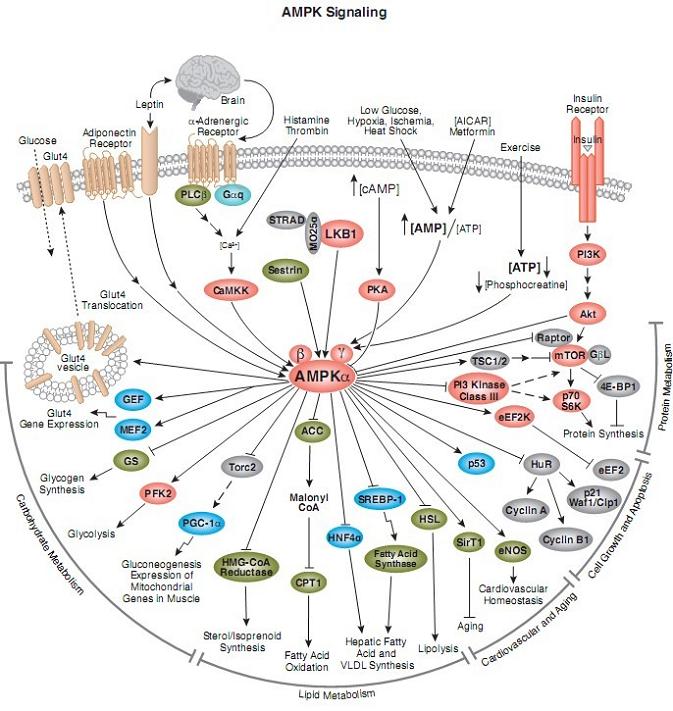AMPK signaling pathway, a fuel sensor and regulator, promotes ATP-producing and inhibits ATP-consuming pathways in various tissues. AMPK is a heterotrimer composed of alpha-catalytic and beta and gamma-regulatory subunits. Humans and rodents have two alpha and beta and three gamma isoforms; some genes are subject to alternative splicing increasing the range of possible heterotrimer combinations. Cellular stresses that inhibit ATP production or increase its consumption change the AMP:ATP ratio and activate the pathway. AMPK activation by AMP is not completely understood; the current model states that binding of AMP to the gamma subunit leads to conformational changes that allosterically activate AMPK and render phosphorylated-Thr172 unavailable for inhibitory dephosphorylation. ATP antagonizes the effect of AMP; both AMP and ATP bind in a mutually exclusive manner to the Bateman (CBS) domains of the gamma subunit. The upstream kinase, known as Lkb1, is a complex of one catalytic and two regulatory subunits; Lkb1 is believed to be ‘constitutively active’. In certain cell types, Thr172 can be phosphorylated by calmodulin-dependent protein kinase kinases (CAmKK), in turn activated by calcium. A well known role of AMPK is in the regulation of lipid metabolism; it stimulates fatty acids oxidation and inhibits their synthesis. Phosphorylation by AMPK inhibits acetyl-CoA carboxylase (ACC) and results in reduced levels of malonyl-CoA product. Malonyl CoA is a substrate in the de novo synthesis of fatty acids and fatty acids elongation. Import antly, it is also an inhibitor of the carnitine palmitoyl transferase I, required for the transfer of primed cytosolic fatty acids into the mitochondrion where they can undergo degradative beta-oxidation. AMPK inhibits mTOR signaling pathway by activating Tsc2 and downstream of Tsc2 by inhibiting Raptor component of mTOR complex 1 [note that this effect is opposite to Tsc2 phosphorylation and inactivation by PI3K-Akt signaling downstream of insulin]. AMPK is also involved in promoting glucose uptake and utilization and integrates adipokynes and hormonal signals in both the hypothalamus and the periphery with potential impact on energy expenditure and uptake by molecular mechanisms that remain to be established. Due to its roles in fuel regulation, the AMPK pathway is regarded as a potential therapeutic target for diabetes type II, obesity and metabolic syndrome. As a note, drugs used in the treatment of insulin resistance and diabetes can activate AMPK.AMP-activated protein kinase (AMPK) plays a key role as a master regulator of cellular energy homeostasis. The kinase is activated in response to stresses that deplete cellular ATP supplies such as low glucose, hypoxia, ischemia and heat shock. It exists as a heterotrimeric complex composed of a catalytic α subunit and regulatory β and γ subunits. Binding of AMP to the γ subunit allosterically activates the complex, making it a more attractive substrate for its major upstream AMPK kinase, LKB1. Several studies indicate that signaling through adiponectin, leptin and CAMKKβ may also be import ant in activating AMPK.
As a cellular energy sensor responding to low ATP levels, AMPK activation positively regulates signaling pathways that replenish cellular ATP supplies. For example, activation of AMPK enhances both the transcript ion and translocation of GLUT4, resulting in an increase in insulin-stimulated glucose uptake. In addition, it also stimulates catabolic processes such as fatty acid oxidation and glycolysis via inhibition of ACC and activation of PFK2. AMPK negatively regulates several proteins central to ATP consuming processes such as TORC2, glycogen synthase, SREBP-1 and TSC2, resulting in the downregulation or inhibition of gluconeogenesis, glycogen, lipid and protein synthesis. Due to its role as a central regulator of both lipid and glucose metabolism, AMPK is considered to be a key therapeutic target for the treatment of obesity, type II diabetes mellitus, and cancer.
本信号转导涉及的信号分子主要包括:
Glut4,Adiponectin Receptor,Leptin,α-Adrenergic Receptor,Insulin Receptor,PLCβ,Gαq,CaMKK,LKB1,STRAD,MO25α,PKA,Sestrin,AMPKα,AMP,ATP,AMPKβ,AMPKγ,PI3K,Akt,mTOR,p70S6K,PI3 Kinase ClassIII,eEF2K,TSC1,TSC2,GβL,4E-BP1,p53,HuR,eEF2,GEF,MEF2,GS,PFK2,Torc2,PGC-1α,ACC,CPT1,HMG-CoA Reductase,HNF4α,SREBP-1,Fatty Acid Synthasa,HSL,SirT1,eNOS,Cyclin A,Cyclin B1,P21,Waf1,Cip1等。
Glut4,Adiponectin Receptor,Leptin,α-Adrenergic Receptor,Insulin Receptor,PLCβ,Gαq,CaMKK,LKB1,STRAD,MO25α,PKA,Sestrin,AMPKα,AMP,ATP,AMPKβ,AMPKγ,PI3K,Akt,mTOR,p70S6K,PI3 Kinase ClassIII,eEF2K,TSC1,TSC2,GβL,4E-BP1,p53,HuR,eEF2,GEF,MEF2,GS,PFK2,Torc2,PGC-1α,ACC,CPT1,HMG-CoA Reductase,HNF4α,SREBP-1,Fatty Acid Synthasa,HSL,SirT1,eNOS,Cyclin A,Cyclin B1,P21,Waf1,Cip1等。
点击图中信号分子,查看详细通路图及产品(抑制剂,抗体,磷酸化抗体,检测试剂盒,重组蛋白等)



